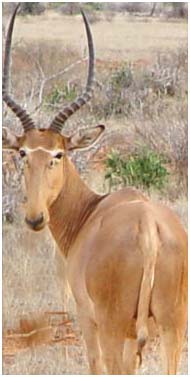Hirola
| Hirola | |
|---|---|

| |
| Scientific classification | |
| Kingdom: | |
| Phylum: | |
| Class: | |
| Order: | |
| Family: | |
| Subfamily: | |
| Genus: | Beatragus
|
| Species: | B. hunteri
|
| Binomial name | |
| Beatragus hunteri | |
| Synonyms | |
|
Damaliscus hunteri | |
The Hirola (Beatragus hunteri, sometimes Damaliscus hunteri also known as Hunter's Hartebeest) is an antelope species found in arid grassy plains in a pocket on the border between Kenya and Somalia. It's the only member of the genus Beatragus.
Hirola are known as the "four-eyed antelope," due to their large preorbital glands. Hirola stand 100 to 125 centimetres at the shoulder and weigh 80 to 118 kilograms. Their coat is a sandy brown colour, greyer in males than females, with a lighter underbelly and a small white strip over the bridge of the nose. The nape of the neck has very thick skin which forms ridges when the ears are pricked up. The horns are lyre shaped and very conspicuously ringed.
They are diurnal and spend the mornings and evenings grazing. Herds contain from two to forty females led by one territorial male but bachelor herds of five or so males are common. Herds do not move much as the males leading them are very territorial. When fighting seriously males drop onto their knees, but when wrestling they remain on all fours.
Hirola are critically endangered. There are between 500 and 1200 animals in the wild as well as a single female in captivity. Counts in the 1970s found around 14,000 animals and another count in the 1980s found 7000 animals. The Hirola's decline is believed to have been brought on by competition with cattle as well as the drought which has plagued the region.
In late 2005, four local communities in the Ijara District have, in collaboration with Terra Nuova, developed and put forward a proposal to formally establish the Ishaqbini Hirola Conservancy for the in situ protection of the Hirola.
Conservation
The Hirola was identified as one of the top-10 "focal species" in 2007 by the Evolutionarily Distinct and Globally Endangered (EDGE) project.[1] EDGE identifies species that are evolutionarily distinct and need better protection to prevent extinction. The Hirola was placed in the top-10 along with Golden-rumped Elephant Shrew, Attenborough's Long-beaked Echidna, Hispaniolan Solenodon, Yangtze River dolphin, Slender loris, Bactrian camel, Pygmy Hippo, Bumblebee bat, and the Long-eared jerboa.[2]
References
- ^ "Protection for 'weirdest' species". BBC. 2007-01-16. Retrieved 2007-05-22.
- ^ "Hexaprotodon liberiensis". EDGE Species. Retrieved 2007-07-31.
- Template:IUCN2006 Listed as Critically Endangered (CR A1a v2.3)
- Muchai, M. et al. (2007) The Distribution, Abundance and Habitat Use of the Hunter's Hartebeest (Hirola); Beatragus hunteri; Sclater, 1889 in Ishaqibini Community Wildlife Conservancy and Arawale National Reserve, Kenya. National Museums of Kenya.
- Andaje, S. A. (2002) Factors limiting the Abundance and Distribution of Hirola in Tsavo and Tana River Districts. Kenyan Wildlife Service: Biodiversity Conservation Unit.
- Muchai, M. et al. (2007) The Distribution, Abundance and Habitat Use of large and medium sized mammals in Ishaqbini Community Wildlife Conservancy, Kenya. National Museums of Kenya.
External links
- EDGE of Existence (Beatragus hunteri) - Saving the World's most Evolutionarily Distinct and Globally Endangered (EDGE) species
- African Wild Dog Conservancy: Wild dogs in the hirola range
- Transboundary Environmental Project (TEP) by Terra Nuova

